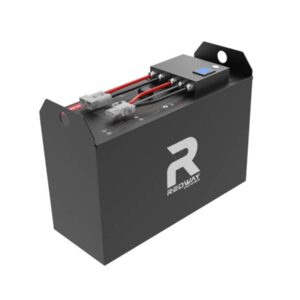How often should I add water to my forklift battery?
Watering frequency for forklift batteries depends on usage intensity, ambient temperature, and battery type. Lead-acid batteries typically require weekly to monthly watering, while lithium-ion units are maintenance-free. Always use distilled water and top up after charging when electrolyte levels settle, keeping plates ¼” submerged. Under-watering accelerates sulfation; overfilling causes acid dilution and spillage risks. Regular hydrometer checks (1.225–1.265 SG) optimize performance.
How to Maximize Forklift Battery Lifespan
What factors determine watering frequency?
Usage cycles, temperature extremes, and battery chemistry dictate watering needs. Heavy-duty forklifts operating 2+ shifts daily may need weekly checks, while light users might stretch to 45 days. High ambient temps above 95°F (35°C) accelerate evaporation by 30% compared to 70°F (21°C) environments.

Battery plates exposed to air start sulfating within 24 hours—a key reason watering must precede plate exposure. Pro Tip: Install automatic watering systems on fleets exceeding 15 units; they reduce labor costs by 60% and prevent human error. For example, a 36V 750Ah battery in a refrigerated warehouse (45°F/7°C) might only require monthly top-ups versus weekly in steel mills.
| High Usage | Low Usage |
|---|---|
| Weekly checks | Monthly checks |
| +25% water consumption | -15% evaporation rate |
What are the signs of low electrolyte levels?
Voltage drops, excessive heat, and visible plate exposure signal low electrolyte. Plates appearing dry or warped beyond 3mm indicate chronic under-watering. Hydrometer readings below 1.225 SG confirm electrolyte imbalance.
When electrolyte falls ½” below plate tops, internal resistance spikes by 40%, causing terminal temperatures to hit 130°F (54°C)—enough to warp separators. Pro Tip: Use infrared thermometers on cell caps; 10°F (5.5°C) variance between cells suggests watering inconsistencies. A real-world case: A distribution center ignored bubbling sounds during charging, leading to 12 corroded cells in their 48V 600Ah battery bank.
| Symptom | Risk Level |
|---|---|
| Exposed plates | Critical |
| SG variance >0.030 | High |
But how do you spot issues without dismantling cells? Opt for transparent vent caps with level markers.
Forklift Battery Maintenance Checklist Essentials
How to safely add water to forklift batteries?
Use distilled water, PPE, and calibrated fillers to maintain safe levels. Fill to ¼” below overflow tubes using drip-resistant nozzles, preventing mineral contamination from tap water that can increase internal resistance by 15%.
Always charge batteries fully before watering—this stabilizes electrolyte density. Pro Tip: Implement the 1/8th rule: If adding over 1/8th of total capacity in water weekly, investigate for overcharging or leaks. For instance, a 48V 1000Ah battery requiring 2 gallons monthly likely has defective cells. Transitional tools like battery watering carts with auto-shutoff nozzles cut refill time by 70% versus manual pitchers. Remember: Overwatering dilutes sulfuric acid, reducing capacity—why risk it when laser-guided fill systems exist?
What happens if I overwater my forklift battery?
Acid spillage, reduced capacity, and terminal corrosion follow overwatering. Excess electrolyte expands during charging, leaking through vents and corroding steel battery trays in 6–8 weeks.
Overfilled cells lose 8–12% specific gravity, equivalent to a 20% capacity drop. Pro Tip: Install float balls in fill ports—they block overflows while allowing gas escape. Imagine a 600Ah battery diluted with 3L excess water: Its runtime plummets from 8 hours to 6.5 hours per charge. Transitionally, facilities using automated systems report 90% fewer acid spills versus manual methods. Ever seen battery racks with white crust? That’s crystallized sulfuric acid from chronic overflows.
How do charging practices affect watering needs?
Equalizing cycles and charge rates directly impact water consumption. Fast charging (C/3 rates) increases gassing by 35%, demanding 20% more frequent watering versus C/5 rates.
Batteries charged 3+ times daily consume water 2.5x faster than single-cycle units. Pro Tip: Schedule equalization charges monthly—they homogenize electrolyte but require post-cycle watering checks. A case study: A port terminal reduced watering labor by 40% after switching from opportunity charging to scheduled 8-hour charges. But what if you’re using older ferroresonant chargers? Upgrade to IUI profile chargers; they decrease water use 18% via optimized voltage tapering.
Battery Expert Insight
FAQs
Can I use tap water in emergencies?
Only if distilled is unavailable—filter first to remove 95% minerals. Permanent tap use increases sulfation risk 8-fold.
How to check levels without removing caps?
Use ultrasonic fluid sensors or transparent refill tubes with float indicators—direct measurement remains most accurate.
Does battery age affect watering frequency?
Yes—5-year-old batteries need 30% more water due to seal degradation and increased gassing from plate erosion.
